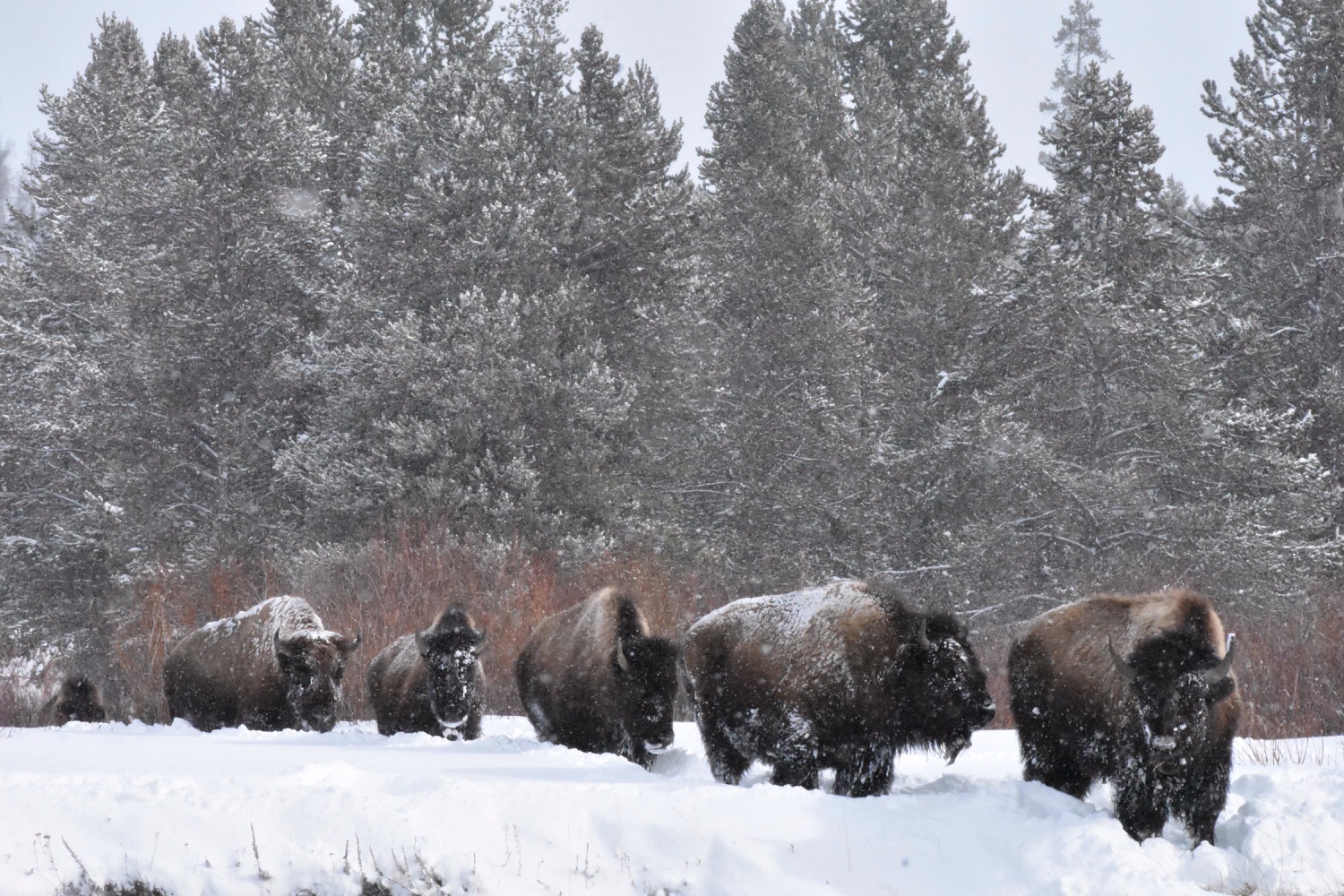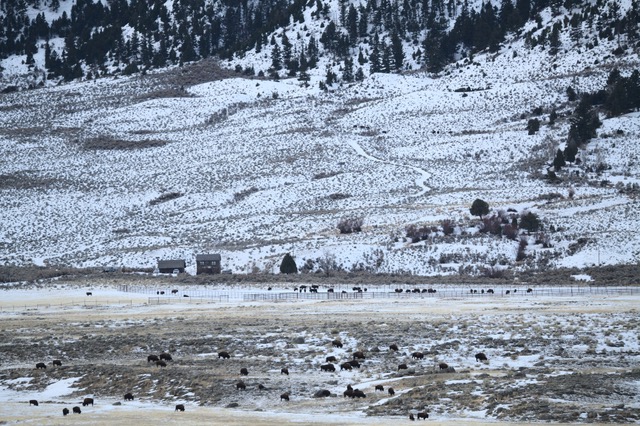Press Release: For Immediate Release
Contacts:
Tom Woodbury, Communications Director
Buffalo Field Campaign
(406) 646-0700 (office)
(650) 238-8759 (private)
Gardiner, MT - The National Park Service commenced trapping operations of America’s National Mammal inside Yellowstone National Park this past weekend. According to Jackson Doyel, a biologist with the Buffalo Field Campaign, it appears for now that the Park Service is utilizing a method they characterize as “passive trapping” at the Stephens Creek trapping facility.

Passive trapping lures wild bison into penned facilities by leaving hay on the ground, before enclosing them in - at which point they cease to be wild. As of Monday, 32 bison that have wandered into the trap, while hundreds more are at risk of a similar fate in the coming weeks. According to Doyel, the trapping has the effect of disrupting the family structure of bison, a highly social species, and excluded family members are regularly observed at the fence-line attempting to remain close to their trapped relatives.
Several hundred bison have been migrating into Montana this winter, due to the combined effects of historic flooding last year followed by the heavy snows and cold that are typical for Yellowstone at this time of the year. Thus far, approximately 145 have been taken by state and tribal hunters, while another 19 have died on Montana’s highways.
Once inside the Stephens Creek Trap, operated at the behest of Montana’s livestock producers, all bison are tested to see if they carry the anti-body for the bacteria that causes bovine brucellosis. Those that test seropositive, meaning that they’ve been exposed to the bacteria at some point in their lives, have historically been shipped to slaughterhouses to satisfy agreed-upon population reduction targets with the State of Montana. This year, however, based upon the latest science from lead Park Biologist Chris Geremia showing bisons’ importance to the ecology of the Park, as well as their importance to the Tribes, the Park Service is committed to managing for an expanding population of wild buffalo, over the State of Montana’s objections. Accordingly, it is anticipated that seropositive bison will be released from Stephens Creek, likely to satisfy increasing hunter demand.
Those bison who test seronegative in the trapping facility, indicating that they’ve never been infected by bovine brucellosis, will be subjected to years of captivity, during which they will be repeatedly tested and otherwise domesticated in order to satisfy the growing demand for increasing Tribal bison herds across the country. While not opposing such transfers, Buffalo Field Campaign maintains that there is no scientific justification for keeping wild bison penned up at Stephens Creek for years as a condition of transfer.
Yellowstone Bison are the most genetically intact buffalo left, being lineal descended from the survivors of the 19th Century ecocide. At one time, the buffalo that inhabited Turtle Island was the most prevalent mammal on the planet.

Why Trap Wild Bison?
The Park Service and State of Montana agree that brucellosis is endemic in Yellowstone’s ecosystem, is transmitted to cattle by elk, and that the risk of transmission from bull bison to cattle is “negligible,” if not scientifically precluded. Cattle producers in the Yellowstone Ecosystem are now required to vaccinate and periodically test their cattle for brucellosis, along with other proactive measures, thus minimizing any increased risk of transmission from bison migrating naturally throughout the Greater Yellowstone Ecosystem.
However, according to a legislative audit, the Montana Department of Livestock “could not demonstrate consistent enforcement” of the rules, and did not conduct “consistent follow-up on cases of apparent noncompliance,” lending support to Buffalo Field Campaign’s assertion that brucellosis is a political red herring, and the real issue is access to forage on public lands by private cattle ranchers.
In 2015, Montana formally decided (Download the PDF) that it was appropriate to allow for the presence of Yellowstone Bison year-round in Montana due to changed circumstances and evolving public attitudes since the 2000 management plan was formulated. In addition to the changes already mentioned, Montana’s Governor pointed to the absence of cattle on Horse Butte, the elimination of grazing allotments in the Taylor Fork drainage, and changes to management by the Forest Service to minimize any risk of transmission.
However, under Montana’s current governor, Greg Gianforte, the Department of Livestock continues to demonstrate extreme prejudice against Yellowstone Bison, in comparison to wild elk for example. In order to protect cattle ranchers access to public lands, Gianforte insists that wild bison populations should be reduced even below those levels necessary to avoid extinction, and the barriers to natural migration corridors imposed by Montana’s Department of Livestock are so restrictive that even experts with Fish, Wildlife & Parks have acknowledge that the resulting conditions for hunting very near the town of Gardiner and busy highways are unsafe.
As they re-establish their relationship to their aboriginal food source after 150 years of forced separation, Tribes like the Nez Perce and Kootenai/Salish are advocating for increased tolerance of wild bison in the 12,000+ square miles of National Forest within the Yellowstone Ecosystem.
The Stephens Creek Trap, operated by the Park Service, is a central component of Montana’s continuing effort to appease livestock interests at the expense of Tribal treaty rights, and part of the machinery for obstructing natural migration of wild bison in Yellowstone. At the most recent meeting of the bison managing partners, the Nez Perce Tribe’s Natural Resource Chairman, Quincy Ellenwood, complained to the State that he was often forced to pull his hunters back from the hunt due to the unsafe conditions imposed by Montana’s Department of Livestock. Tom McDonald, Council Chairman for the Confedrated Salish and Kootenai Tribes, seemed to express the sentiments of all the managing partners apart from Montana Livestock that the answer to all questions concerning Yellowstone’s bison is “habitat, habitat, habitat.”
Montana’s Unlawful Interference With Tribal Hunting
Buffalo Field Campaign’s Communication Director, Tom Woodbury, points out that the Stephens Creek Trap is unnecessary, inconsistent with the Park’s mission and role as wildlife steward, and should be dismantled. “This is no way to treat our National Mammal,” Woodbury said. “There is zero scientific rationale for treating migrating bison any different than migrating elk or antelope,” Woodbury maintained. Park Superintendent Cam Sholly made the same point last year in response to the Department of Livestock’s senseless killing of a lone bull bison that had migrated all the way up to Paradise Valley near Pray, Montana.
Recent rulings from the U.S. Supreme Court recognizing the primacy of off-reservation Tribal treaty hunting rights calls into question Montana’s continuing insistence on severely restricting the natural migrations of Yellowstone’s buffalo into the Greater Yellowstone Ecosystem. Specifically, the Court in 2019 ruled that Treaty Tribes retain a “virtually unqualified right” to hunt on National Forest lands. See: Herrera v. Wyoming (Download the PDF). The Court reinforced an earlier decision finding that a Tribes’ exercise of off-reservation hunting and fishing rights, which are considered to the supreme law of the land under Article Six of the U.S. Constitution, is “immune” from State regulation. See: 443 U.S. 658, at 682 (1979).
The only permissible grounds for a state interference with Tribal treaty rights (p. 770) (Download the PDF), according to the Supreme Court, is where the state can show that its actions are necessary to conserve the species. The State of Montana has never expressed any interest in conserving wild bison, as opposed to protecting private livestock interests, and its outdated expression of intolerance towards the presence of wild bison throughout the Custer-Gallatin National Forest appears to be contrary to Supreme Court edicts in Herrera, which involved tribal hunting on the Bighorn National Forest, and related cases.
According to Woodbury, “It is only a matter of time before the State of Montana’s anti-wildlife stance is struck down as unlawful. The Park Service is to be commended for following science in managing for a growing population of bison,” Woodbury continued, “but they are being inconsistent by trapping wild bison for the sin of carrying the same bacteria that wild, migrating elk regularly transmit to cows.”
